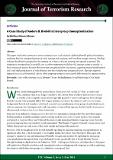Files in this item
A case study of Anders B. Breivik’s intergroup conceptualisation
Item metadata
| dc.contributor.author | Holmen Johnsen, Mathias | |
| dc.coverage.spatial | 11 | en_US |
| dc.date.accessioned | 2014-06-30T13:34:32Z | |
| dc.date.available | 2014-06-30T13:34:32Z | |
| dc.date.issued | 2014-06-02 | |
| dc.identifier.citation | Holmen Johnsen, M. (2014). A Case Study of Anders B. Breivik’s Intergroup Conceptualisation. Journal Of Terrorism Research, 5(2), pp. 1-11. | en_US |
| dc.identifier.issn | 2049-7040 | en_US |
| dc.identifier.uri | http://ojs.st-andrews.ac.uk/index.php/jtr/article/view/879/732 | en_US |
| dc.identifier.uri | https://hdl.handle.net/10023/4925 | |
| dc.description.abstract | This paper undertakes summative content analytical case study of Anders Behring Breivik’s political manifesto, analysing Breivik’s conceptualisations of social ingroup and outgroup, and how these concepts interact. Findings indicate that Breivik conceptualises his ingroup on a three-level scale, ranging from specific to general. The outgroup is conceptualised as twofold, seen as either originating inside Breivik’s ingroup society or outside. A basic interaction pattern between the two group-conceptualisations was found, suggesting mutual reinforcement and a self-replicating pattern of radicalization and entrenched group-conceptualisation. Ingroup categories appeared to exist as hierarchical subsets, while outgroup categories were clearly differentiated as separate entities. | en_US |
| dc.language.iso | en | en_US |
| dc.publisher | Centre for the Study of Terrorism and Political Violence, University of St Andrews | en_US |
| dc.relation.ispartof | Journal of Terrorism Research | en_US |
| dc.rights | This is an open access article published in Journal of Terrorism Research. This work is licensed under a Creative Commons Attribution 3.0 License (http://creativecommons.org/licenses/by/3.0/) | en_US |
| dc.rights.uri | http://creativecommons.org/licenses/by/3.0/ | |
| dc.subject | Lone-wolf terrorism | en_US |
| dc.subject | Social Identity Theory | en_US |
| dc.subject | Radicalisation | en_US |
| dc.subject | Social Psychology | en_US |
| dc.subject | Case Study | en_US |
| dc.subject | Breivik | en_US |
| dc.subject.lcc | HV6431 | en_US |
| dc.subject.lcsh | Terrorists -- Norway | en_US |
| dc.subject.lcsh | Intergroup relations | en_US |
| dc.subject.lcsh | Breivik, Anders Behring, 1979- | en_US |
| dc.subject.lcsh | Terrorism | en_US |
| dc.title | A case study of Anders B. Breivik’s intergroup conceptualisation | en_US |
| dc.type | Journal article | en_US |
| dc.description.version | https://doi.org/Publisher PDF | en_US |
| dc.publicationstatus | Published | en_US |
| dc.status | Peer reviewed | en_US |
| dc.identifier.doi | https://doi.org/http://doi.org/10.15664/jtr.879 | en |
This item appears in the following Collection(s)
Except where otherwise noted within the work, this item's licence for re-use is described as This is an open access article published in Journal of Terrorism Research. This work is licensed under a Creative Commons Attribution 3.0 License (http://creativecommons.org/licenses/by/3.0/)
Items in the St Andrews Research Repository are protected by copyright, with all rights reserved, unless otherwise indicated.


